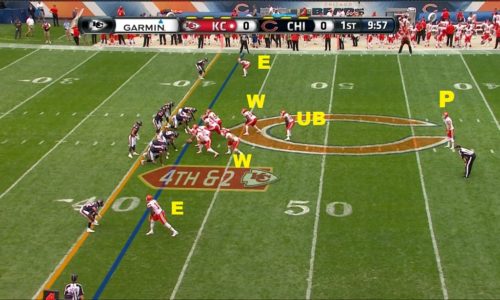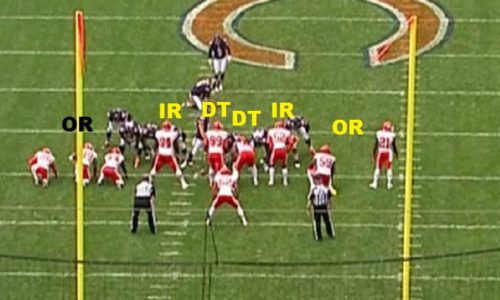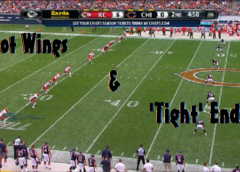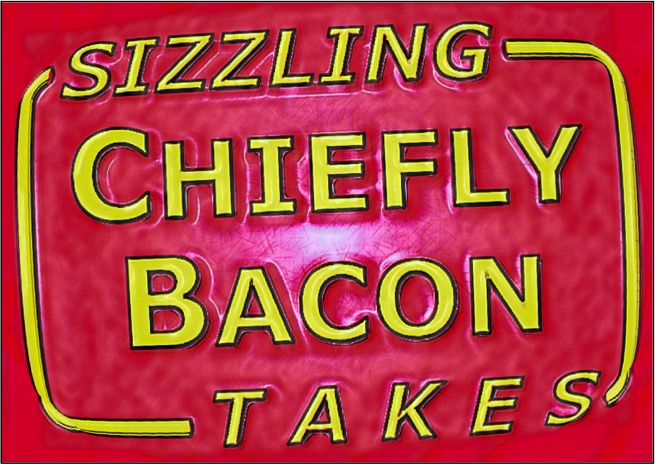 Hot Wings and ‘Tight’ Ends: Making the Bottom of the Roster
Hot Wings and ‘Tight’ Ends: Making the Bottom of the Roster
![]()
![]()
Most fans are well acquainted with the positions on both offense and defense. If you’re crazy enough to pay attention to preseason football, you probably even have some favorite rookies or young vets you’d like to make the team. The funny thing is, every year, some player wows us against 2nd stringers and looks ready to contribute in the near future, only to be lost in the final round of cuts. Fred Williams played this role in 2015 and, I suspect, Rod Steater’s departure was along similar lines. Simultaneously, players we desperately want cut (Frankie Hammond is finally gone!) somehow make the roster. While everyone knows that these decisions have something to do with special teams, our understanding of special teams usually only allows us to say that a guy is either good or bad at special teams with few specifics. My natural curiosity, along with my passion for UDFAs and late round picks, made me decide to look into the roles some of these players fill and the skills that make them useful to Dave Toub.
![]()
Steelers Special teams coach Danny Smith always tell rookies: “If you’re not a starter on defense or offense, then you better be a starter on special teams or we don’t have a spot for you.” Special teams basically does six things. They kickoff the ball, return kickoffs, kick field goals, block field goals, punt and return punts. That seems like a lot of positions, but there’s some redundancy and Field Goal tries generally include the offensive line. A few spots are also taken up by the specialists: the long snapper, the punter and the kicker. If you want to make it on special teams, there’s pretty stiff competition, but these are the spots where you have the best shot:
![]()
End/Gunner
Wings
Upback/Personal Protector
Jammer
Kick Returner
Punt Returne
Inside Rushers/Blickers
Outside Rushers/Blockers
![]()
End/Gunner
The ends are bringing the heat when Colquit punts the ball. You’ll see these guys way out on the edge. Ends have to be fast, strong and agile, these players are generally either DBs or WRs (though Chiefs have given Knile Davis a few looks there this preseason). A good end will generally draw a double team at the line and he’s still expected to be the first player to the ball. This position is great for developing young WRs, because it teaches them tactics that help against press coverage. The Chiefs played Chris Conely at End some last year. Against the Bears, Chiefs were playing DeMarcus Robinson and Jamell Flemming here. Performing well as a Gunner was likely a major reason Robinson made the roster.
![]()
Wings
Wings are players who line up behind and slightly outside the tackles in punt and field goal kicking formations. They are tasked with watching the edge and keeping rushers away from the punter or kicker. Wings are generally stout players like TEs or LBs. They have to be sturdy enough to block well, but fast enough to hustle down the field once the punt is away. Chiefs played Sherman and March here on punts with Kelcie replacing March in field goal formations.
![]()
Up Back/Personal Protector
 The up back/personal protector is Colquit’s last line of defense. It’s his job to clean up anyone who manages to get through the line. This task demands a certain level of strength and toughness, but, because the UB is also the last one to head down-field to tackle the returner, he also has to be fast. The up back (UB) is often the one to take the snap in fake punt situations and the position is generally played by a RB. Last year, Chiefs played Charcandrick West in this spot, but this year, Toub has made a bold choice in Tyreek Hill. While Hill isn’t the biggest guy, he’s built well enough to slow down the occasional safety who might slip past. Where he really shines though is his speed. Teams might be reluctant to bring the fire on the edge knowing that, if it’s a fake, Hill will be halfway to the end-zone before they even realize Colquitt doesn’t have the ball. If Chiefs don’t fake it, Hill’s speed is still a huge asset, because, unlike most UBs, he has the speed to be the first or second guy to the returner in spite of leaving last. It’s like having an extra gunner who’s less likely to get blocked. This selection shows once again why Toub is one of the best Special Teams coaches in the entire league.
The up back/personal protector is Colquit’s last line of defense. It’s his job to clean up anyone who manages to get through the line. This task demands a certain level of strength and toughness, but, because the UB is also the last one to head down-field to tackle the returner, he also has to be fast. The up back (UB) is often the one to take the snap in fake punt situations and the position is generally played by a RB. Last year, Chiefs played Charcandrick West in this spot, but this year, Toub has made a bold choice in Tyreek Hill. While Hill isn’t the biggest guy, he’s built well enough to slow down the occasional safety who might slip past. Where he really shines though is his speed. Teams might be reluctant to bring the fire on the edge knowing that, if it’s a fake, Hill will be halfway to the end-zone before they even realize Colquitt doesn’t have the ball. If Chiefs don’t fake it, Hill’s speed is still a huge asset, because, unlike most UBs, he has the speed to be the first or second guy to the returner in spite of leaving last. It’s like having an extra gunner who’s less likely to get blocked. This selection shows once again why Toub is one of the best Special Teams coaches in the entire league.
![]()

![]()
Jammer
A Jammer is a guy who plays opposite the opposing team’s Gunner. In punt formations, teams typically employ two Jammers on each side, essentially double teaming both gunners. Jammer’s are typically CBs or safeties because of their experience with press coverage. Against the Bears, Chiefs used Eric Murray, DJ White, Steven Nelson and Jamell Flemming or Marcus Cooper as Jammers. Playing this position is one of the reasons Chiefs found a spot for D.J. White and, if they hadn’t traded for Acker, they might have kept Cooper too. Flemming played a lot of spots on special teams, Toub is going to miss him, but Chiefs have rookies with more upside and Toub will have to make do with them.
![]()

![]()
Kick Returner
The casual fan often doesn’t realize just how different punt returners and kick returners are. While some players can do both, the ideal characteristics for each position are very different. Kick returners have to be fast first and foremost. They should cover as much ground as possible in a straight line before the coverage unit gets there. This helps limit losses if they aren’t able to make the first guy miss. The second thing you look for in a KR is size/toughness. He’s likely going to have to run full speed into other players running full speed at him. His body needs to be built to take that impact on a regular basis. Finally, a kick returner needs to be decisive and have good vision. A punt returner who dances too much doesn’t lose his team many yards. A KR who makes slow or poor decisions leads to much worse field position. Chiefs still have Knile Davis because he fits this position to a T. Tyreek Hill can return kicks, but, even though he’s sturdier than DAT, you have to wonder how long he’ll hold up in that role.
![]()
Punt Returner
A punt returner’s most important trait is good hands. If a KR drops a kickoff, he can scoop it back up and take a knee. If a PR muffs a catch, the other team has a 50/50 chance of getting the ball back close to their end zone. The second most important trait is agility. Acceleration is more important than top speed. Punt coverage units are on you much faster than kick coverage units. If you can’t make the first guy and the second guy both miss, you won’t gain more than five yards. Beyond that, speed helps and vision is important. Size isn’t as critical for a PR because players usually aren’t hitting him full speed, as long as he knows when to call for a fair catch.
![]()
Inside Rushers/Blockers
The rest of the guys on STs don’t really have specific names attached to their positions as far as I can tell, but the guys you see on the inside are a little different from the ones you see on the outside. The field goal blocking team looks a lot like the 2nd string defense with D-line in the middle and OLBs on the edge. On punts, the inside guys are generally Demetrius Harris, James O’Shaugnessy, DJ Alexander and Daniel Sorenson. Players at these positions don’t have any one body type or ability. They just have to play hard with good technique and be able to block, tackle and maintain discipline to avoid getting burned by cutbacks. It’s not a glamorous job, but it’s important.
![]()
Outside Rushers/Blockers
Outsider rushers are pretty similar to the inside guys. Main difference being, they tend to be actual pass rushers and almost exclusively OLBs (in a 3-4). Frnak Zombo, Andy Mulumba, Justin March and Dadi Nicolas all saw time here during preseason. These guys have an actual shot at blocking a punt or a field goal, but it’s pretty rare. Their main job is to force the kick in a timely fashion so the returner has more time to work with. Punters will sometimes delay their kick slightly against teams with bad outside rushers on STs. It might not seem like much, but a second can be the difference between the gunner downing the ball at the one and a touch-back. That one second can cost you 19 yards and kill a drive before it starts. On some plays, an outside rusher will hold back and block rather than go all out for the punter. This helps the team stay unpredictable and create space for the returner to work with.
![]()

![]()
With the 53 man roster finalized, it’s pretty clear that the bottom of the roster guys have each found their niche on special teams. DAT as a PR, DeMarcus Robinson as gunner, DJ White and Eric Murray as a Jammers, Tyreek Hill as a KR/PR/Personal Protector, Knile Davis as a KR, Dadi Nicolas as an outside rusher and James O’Shaunessy as an inside blocker. Ramik Wilson’s inability to nail down a starting spot on special teams undoubtedly played a role in his release for Sam Barrington. In speaking on Barrington, Dorsey noted his ability to play Special Teams.
![]()


